
Earlier this summer my friend Andrea casually mentioned that she was planning to join Island Nature Trust’s guided walk to St. Peters Island.
My ears immediately pricked up: if I am a lover of islands, I am doubly a lover of the islands-of-islands, and also a lover of visits to seldom-visited places, so this was right up my alley. I immediately registered my interest, something I timed perfectly as the CBC publicized the opportunity the next day, and the list of spots immediately filled to the brim and over.
Which is how I found myself standing on the end of the Hennebury Road in Rice Point this morning at 10:30 a.m. sharp, pack filled with water and two granola bars, staring at the feet of the other intrepid to compare my footwear choice to theirs.
There was, I learned quickly, no consensus on the appropriate footwear, as what I saw ranged from bare feet (sported by the extra-especially-intrepid Ed MacDonald) to flip-flops to water shoes to rubber boots to people, like me, who decided to make no concession whatsoever to the environs and wear what we wear every day.
My small intrepid sub-group consisted of Sandy (the driver), Andrea (the instigator), Ruth (heretofore known only in lore as “my good friend Ruth” in frequent mentions by Andrea) and Ruth’s cousin Kim. If you are an expert Islander, you should have no trouble triangulating their full identities.
After a briefing from Island Nature Trust staffers, our group of 40 headed down a cut in the cliffs to the beach. Low tide was coming up at about 11:40 a.m., but there was a mostly-not-underwater path clear once we’d rounded the point and walked by Camp Seggie, where we could see our destination in the distance:

The advice from Island Nature Trust on footwear was:
Please wear footwear and clothing that you don’t mind getting wet or possibly muddy.
I must admit that, before we set out, I’d imagined that I would be able to successfully hopscotch from sandbar to sandbar and remain completely dry. This was not the case: the way was certainly low-tidey, but there were periods of wading (never beyond my calves) that required an adjustment to my general aversion to mud and wetness. When on the tidal flats, do as the tidal flatters do.
This is what our route across and back looked like, tracked by OsmAnd on my phone:
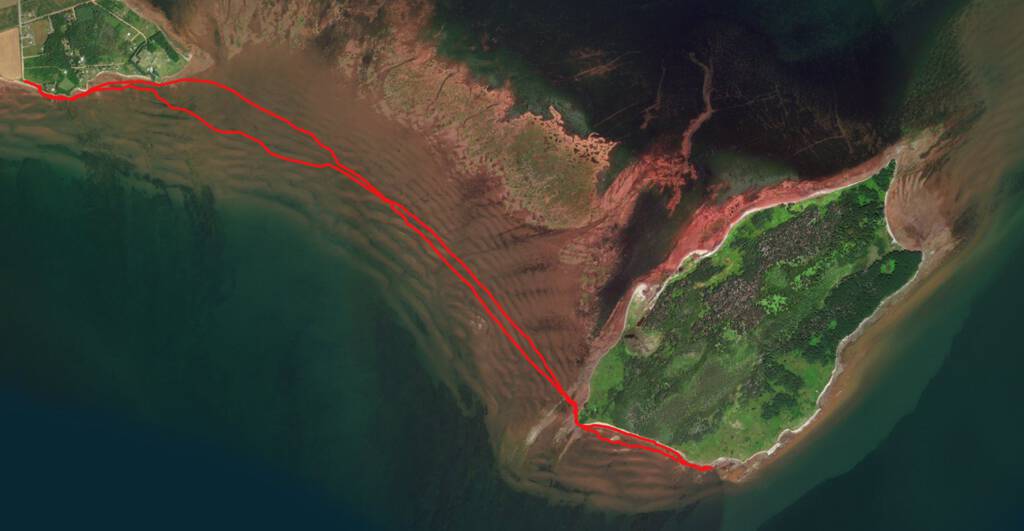
The weather was about as beautiful as you could possibly ask for, the company collegial and entertaining, and once I got used to having wet feet I decided that I should walk around with wet feet all the time.
We made landfall on St. Peter’s Island at 11:34 a.m., making the journey from Island to island almost exactly 60 minutes. We then walked around the western tip and along its south shore. The tide was now fully low, and the way was clear, if a little slippery.
Here’s Andrea, Ruth and Kim making their way:
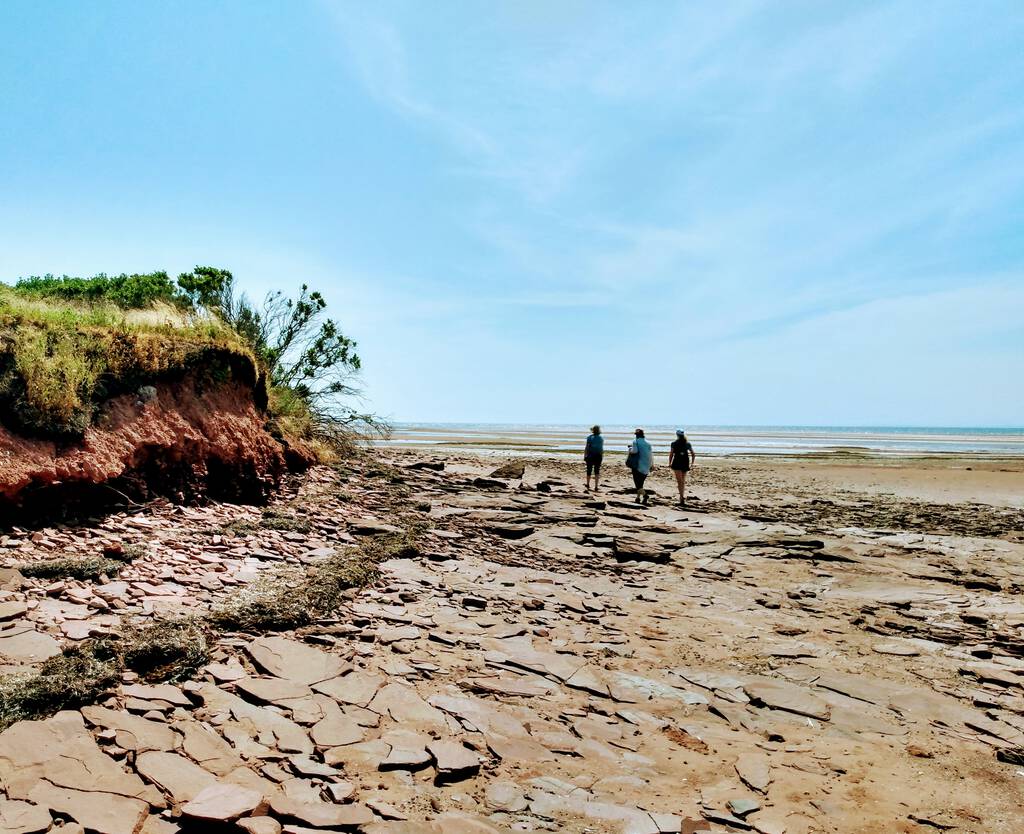
While many among us were demonstrably more hardcore birders, naturalists, and rock-hounds, I was happy to find that our sub-group was comfortable ambling and chatting and having a sit-down.
I tried to take photos that might capture the wonders of St. Peters Island and its coast, but they ended up mostly being washed out and insufficiently capturing of the rough grandeur. Which is okay by me, as the experience did seem to be one that needs to be experienced to capture its true essence.
We reached the farthest point of our journey just before 12 noon, and then retraced our steps to the launching-off point where we stopped for a group photo:
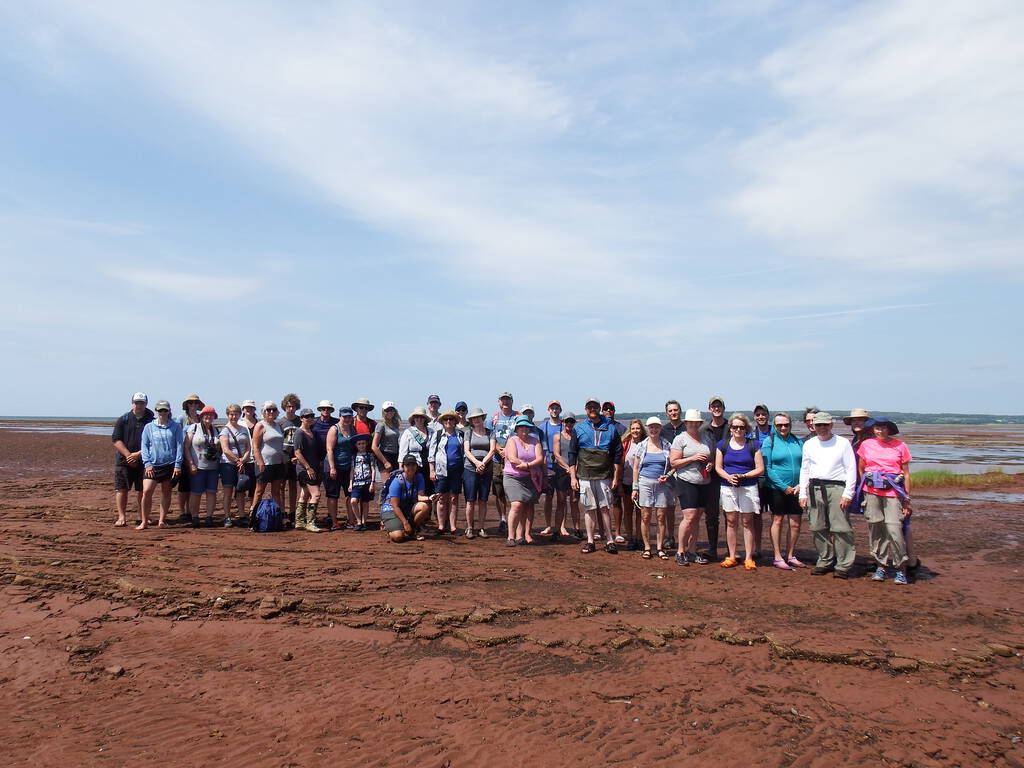
The way back, even though only an hour after low tide, was somewhat more rough-going, with deeper pools to wade through (this might have been, in part, because we lollygagged and paid insufficient attention to the smarter hikers who were better at wending). Here’s what the view of Prince Edward Island looked like from the shore of St. Peters Island:
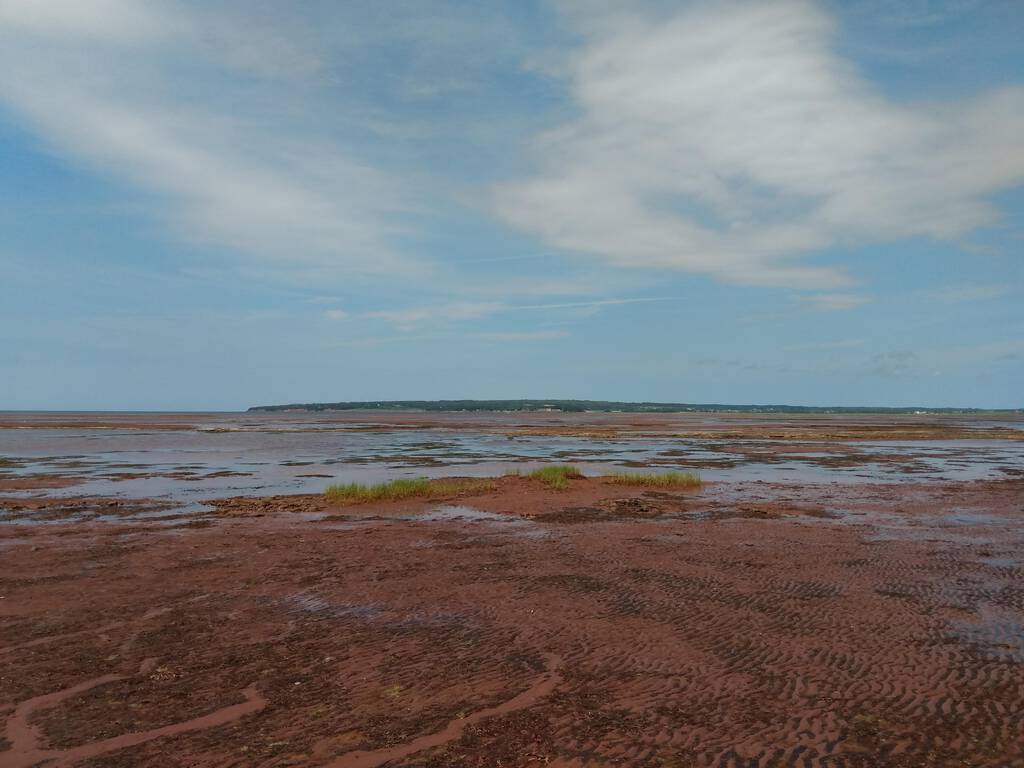
We set off from the St. Peters Island coast at 12:30 p.m. and arrived on the “mainland” at 1:20 p.m., making better time on the way back than there, despite the wading.
It was an exceptional experience that I’d recommend to anyone: joining Island Nature Trust and therein getting a subscription to their newsletter is perhaps the best way to keep abreast of your next opportunity.
(The benefit of going with Island Nature Trust is that they’ve got the experience to pick a date with the right combination of tides and winds; there’s nothing to prevent you from going over independently, but you run the risk of misjudging the timing and being stranded for 12 hours until the next low tide).
The second issue of Desired Landscapes arrived in the post today; what a lovely package.
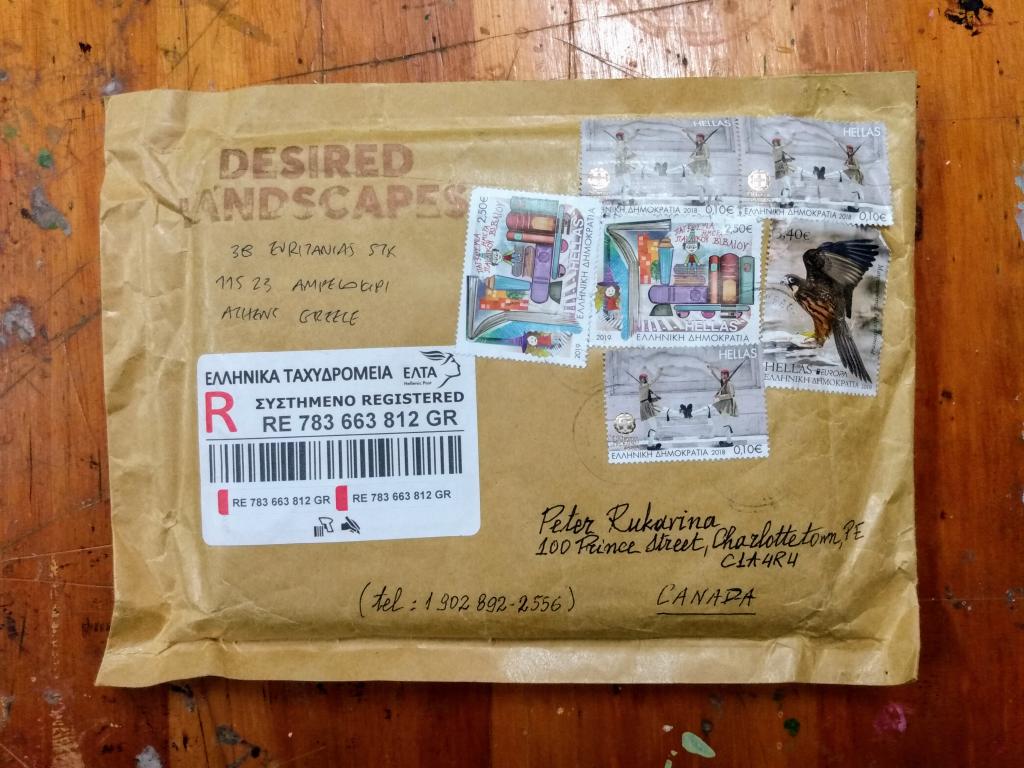
In today’s email came a link to Grades Are Capitalism in Action. Let’s Get Them Out of Our Schools., an op-ed on Truthout, that concludes:
Meritocracy redirects the blame for capitalism’s failures onto its victims. Schools teach meritocracy, and grading is the method.
That the email with the link came from a lifelong Island educator, someone with whom I’ve enjoyed myriad conversations about education and learning, is a hopeful sign that we’re starting to move our thinking about education in the right direction.
I’ve been doing the weekly shop with my bicycle and the cannibalized cycle trailer of the Atkinson-Bateman children, with a giant plastic tub bungied to the top.
Tonight’s grocery shop ended up being too big to contain, which necessitated some creative extra-bungie.
This reminds me of the time our Nissan Sentra was squeezed on the ferry John Hamilton Gray outside the vehicle decks, in the middle of winter. We were certain that the car was going to end up at the bottom of the Northumberland Strait.
Fortunately, both Sentra and toilet roll survived their journeys.
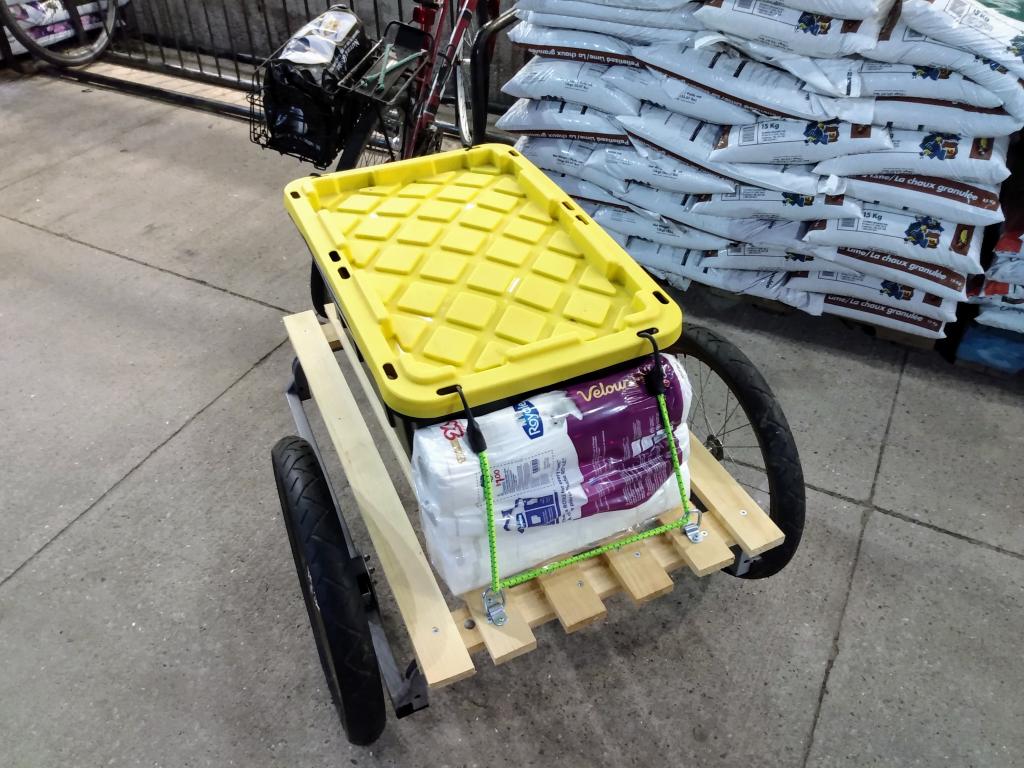
The Province of Prince Edward Island announced a solar energy incentive program last week, one that will cover up to 40% of the cost of solar panel installation, to a maximum of $10,000, for farms, homes and businesses.
It is hard to begrudge any program that seeks to migrate our energy generation to renewable sources; but it’s hard not to despair at what a drop in the bucket this ambitious program, with $2 million of funding, will make in helping us meet our 2030 target of a 600,000 tonne annual reduction in our provincial emissions:
“Solar incentives will add to our energy mix, creating more made-in-PEI electricity,” said Transportation, Infrastructure and Energy Minister Steven Myers. “Islanders want to help tackle climate change and they want to save money on electricity. Solar energy will reduce greenhouse gas emissions by over 500 tonnes annually while helping people become more energy independent.”
To save you the math, 500 is 0.08% of 600,000.
That’s not nothing, but it seems a lot closer to nothing than it does to something, given that 2030 is now only 11 years away.
Of course a solar incentive program, like an electric vehicle incentive program, may not be intended to actually solve the problem, but rather to stimulate the solution of the problem by the market. I’m sure the thinking goes something like “we need to build expertise and capacity in renewable energy, and to solve the chicken and egg problem of cost and market stability, we’ll kick things off with some cash.”
And solar energy is only one part of our emissions reduction strategy related to energy (in fact the word “solar” doesn’t even appear in our Climate Action Plan).
But chipping off this 600,000 tonne emissions mountain 500 tonnes at a time is going to make for a long, slow slog.
For the sixth year in a row, Reinvented was a corporate sponsor of The Island Fringe Festival, which, for my money, is about the best and most useful investment I make every year.
Oliver and I was 8 of the 9 Fringe shows; not a perfect score, but as close as we’ve ever come.
Here’s a thumbnail review of what we saw:
- The Bessie Carruthers Study Club – Produced by friends of mine, this a delightful musical rumination on the suffragettes of Prince Edward Island, circa 1919. That I enjoyed this, despite my aversion to musical theatre and, indeed, that I even joined in when prompted, singing from the provided lyrics sheet, is a testament to the compelling characters drawn by Suzanne Campbell and Jennifer King, and their musical talent at the voice and piano respectively. I love having friends whose idea of a fun summertime side-project is to self-produce a musical about women gaining the right to vote.
- Artisanal Intelligence – Two very skilled actors from British Columbia in a show about robots, artificial intelligence, relationships, love, and rejection. The show was well-polished and supported by a commendable publicity effort. I proudly sport an Artisanal Intelligence button on my lapel.
- Dead People Are Liking Things On Facebook – A lecture cum live Facebook demonstration that starts from the question “how was it that my friend ‘liked’ Coca-Cola on Facebook despite the fact that they were long dead” and goes on to explore notions of God, gay culture, loss, addiction, and whether Facebook is the new religion. The show was punctuated by my seatmate’s phone spontaneously starting to play CBC Radio in his pocket, something that felt kind of like it belonged as part of the performance.
- Magic Hour Plus – A magic show presented by two talented doofuses joined by a very talented magician “intern.” Shouldn’t work, shouldn’t be enjoyable. But somehow it is.
- Worldly Women – Almost indescribably good. A powerful dance performance, inventively choreographed, presented by a seemingly indefatigable troupe of dancers.
- How To Be A Lady – We are blessed with a another dance-focused all-woman group, in this case performing show “created using only the word ‘lady’ as the initial springboard for imagination and collaboration.” They do this with a mixture of song, story, dance and movement. The effect was mesmerizing.
- Still Looking – An unbelievable third show at this year’s Fringe that was rooted in creative movement: a brilliant montage of moments in the relationship between two people, played out in the tiny confines of the Kettle Black coffee shop.
- That’s Not How It Happened – A one-woman show from New York’s Colleen Hindsley about growing up in a complicated family. Hindsley is a skilled performer and an excellent storyteller.
Things finished up with the “Awards and Wrap-Up Party” at The Haviland Club on Sunday evening: Worldly Women won the “Patron’s Pick,” while L’asexualité des abeilles–alas the only show we didn’t see–won both the “Staff Pick” and the “Artists’ Pick.”
This was, without a doubt, the best Island Fringe yet: the random fates of the lottery that chose the artists shone well upon us this year, and there was not a dud in the lot.
I’ve already got the cheque made out for my 2020 sponsorship.
Here’s a photo of Oliver on his bike riding to the Charlottetown Farmers’ Market yesterday along the Confederation Trail:
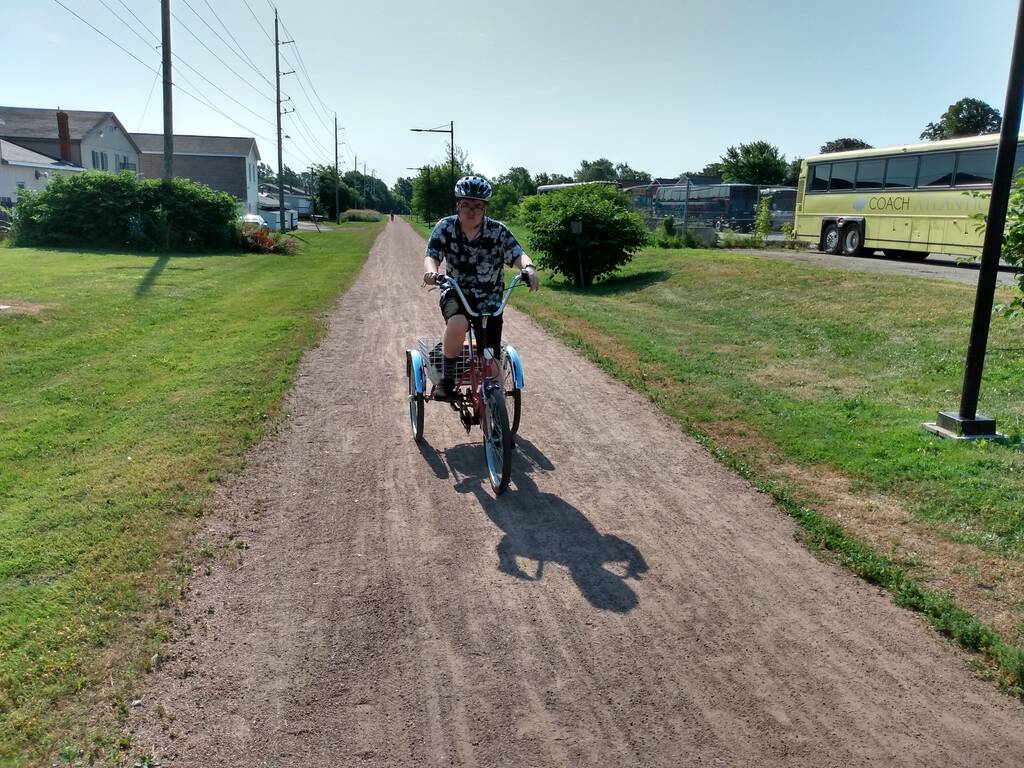
You may see that photo and think “oh, riding to the market, what a nice idea.”
I look at the photo and see years of effort culminating in extreme bravery: it was an amazing feat, especially given that Oliver only started cycling in earnest a week ago.
The tricycle he’s riding is a Fiori Parklane that we purchased on Friday from MacQueen’s after renting it the previous weekend for a try-before-you-buy. It’s stable enough that Oliver’s skittishness about “tippiness” is mitigated. It’s easy enough to pedal that the 6 km round trip from home to the market was reasonable. It’s got a generous basket in the back that allowed Oliver to bear the brunt of getting our market purchases back home.
Along the way we realized that our regular Saturday local food trail is almost 100% accessible by bicycle: we can ride up the Confederation Trail to the Farmers’ Market, then back down to the Kensington Road-Fitzroy-Escher intersection and take the multi-use path up to Riverview Country Market, then come back around and stop at Purity Dairy and, finally, continue on to Receiver Coffee along the Event Grounds trail:
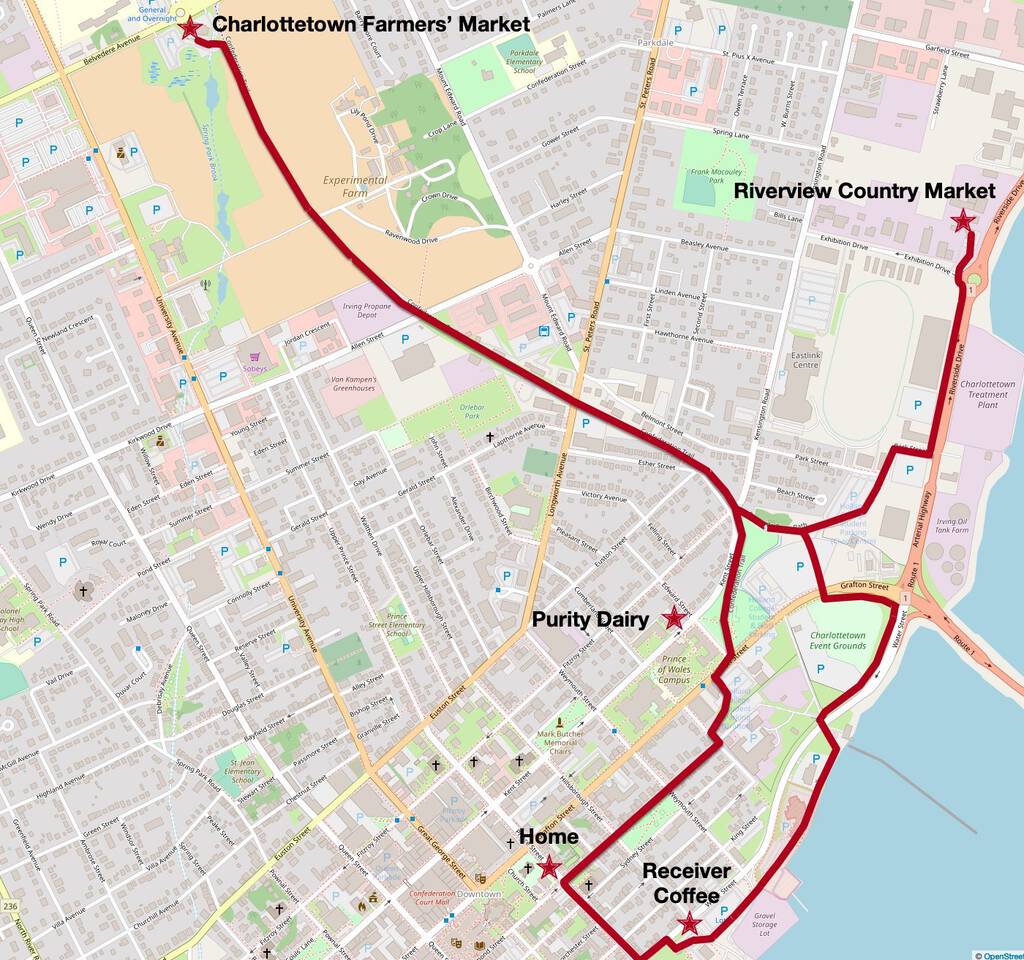
We didn’t hit all the stops this week, just the market and Purity Dairy (where we had a nice chat with personable owner Tom Cullen); we’ll expand the footprint as comfort level increases in the weeks and months to come.
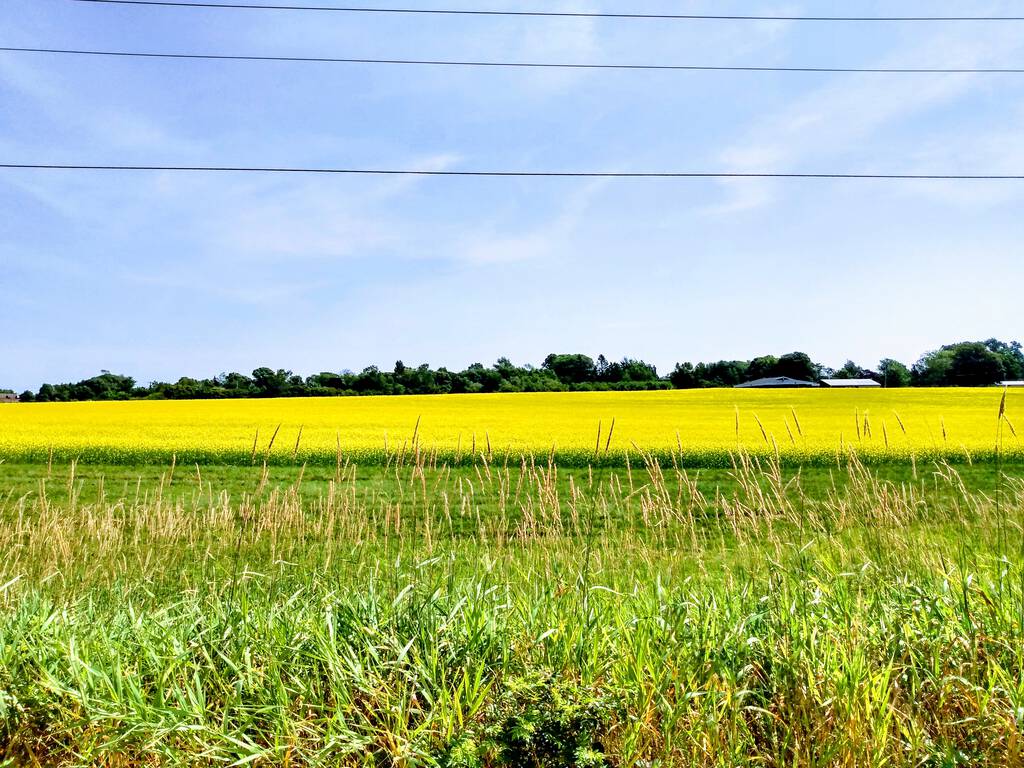
 I am
I am